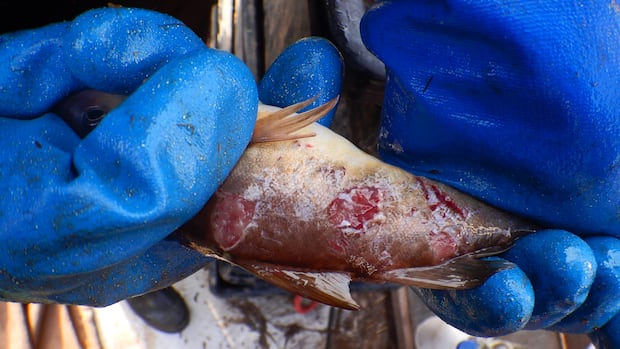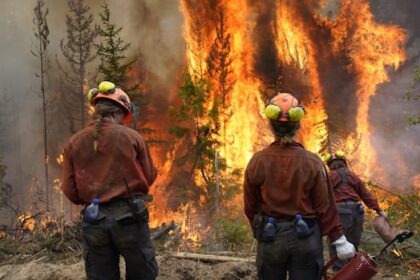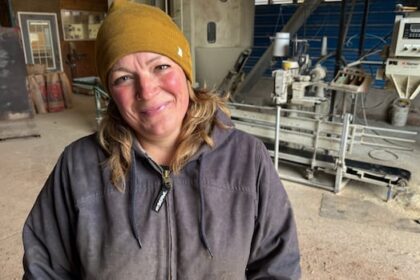Nova ScotiaA New Minas fisherman and environmentalist says he sees the harm that ill-functioning culverts inflict on fish in Nova Scotia every day. In some cases, he says, the results are deadly. More than half of the province’s water crossings cause problems for fish passage, says biologistListen to this articleEstimated 4 minutesA pair of culverts on the Halfway River near Hantsport, where a fisherman says fish get injured during high tide. (Darren Porter)A New Minas, N.S., man says he sees the harm that ill-functioning culverts inflict on fish in Nova Scotia every day.In some cases, Darren Porter says, the results are deadly.Porter, a commercial fisherman and environmentalist, points to a pair of culverts on the Halfway River near Hantsport, N.S., where strong currents during high tide propel fish through them with such force that it can maim or even kill them.“Just imagine the fish being pulled through or shoved through that,” he said. “It’s inhumane.”Porter has documented the injuries to fish in photographs that reveal deep wounds, hemorrhaging and even prolapse, the protrusion of internal organs due to trauma.Faulty culverts are far from a rare problem. Thomas Sweeney, a habitat biologist with the Nova Scotia Salmon Association, says that between 50 and 60 per cent of Nova Scotia’s 31,000 water crossings — where roads cross streams or rivers — cause problems for fish passage. A 2023 Fisheries and Oceans Canada report found similar results: between 45 and 57 per cent of culverts in four major Nova Scotia watersheds — the Annapolis, Shubenacadie, St. Mary’s and LaHave — were classified as barriers to fish.“In many ways, it’s death by a thousand cuts. When [the fish] hit barriers, their populations are threatened across a lot of their range,” said Sweeney, adding that migratory species such as salmon are the most affected. Fisherman Darren Porter says he sees fish injured by faulty culverts every day. (Darren Porter)Problems can include culverts that are damaged, obstructed by debris or poorly designed, either not allowing sufficient water to pass or having too much water rushing through at a high velocity.Porter wants DFO to hold culvert owners accountable by more actively enforcing the Fisheries Act, particularly Section 35 that prohibits harming or destroying fish habitat. Violating that section can lead to heavy fines and even prison time. “As soon as you start enforcing the law, people come into compliance,” he said. “Once people come into compliance, we fix the problem. It’s pretty simple. Until that happens, we’re dead in the water.”Culvert owners can be government agencies, municipalities, industries or private landowners. Nova Scotia’s Department of Public Works, which owns many of the province’s culverts, confirmed it does not track how many negatively impact fish passage.“When Public Works receives an order from DFO, we make the necessary changes. We do not track the number or type of orders we receive,” a department spokesperson said in an email, declining further comment.Porter wants better enforcement measures to crack down on the owners of faulty culverts that are harming fish populations. (Darren Porter)A DFO spokesperson said when the department is made aware of an obstructed passage, it can order the culvert owner to take corrective measures within a specific time frame.“While voluntary compliance is both the preferred and expected approach, enforcement action, and charges can be laid when circumstances warrant — particularly if a proponent fails to meet the necessary requirements to achieve compliance,” the spokesperson said in an email.When asked by CBC News how many documented violations of the Fisheries Act over the last 10 years involved culverts, DFO said “current data systems do not have the capability to isolate or identify which specific incidents involved dams or culverts.”CBC News asked DFO for an interview, but the department wasn’t able to accommodate one.Calls for better trackingSweeney said better tracking could at least make the problem more manageable and give agencies the ability to prioritize which culverts to fix with a limited budget.He said people could play a role through adopt-a-stream programs that can train them on how to assess culverts and record them in a database.“If we take this huge, insurmountable problem and start breaking it down watershed by watershed, even tributary by tributary, that’s how we make headway.”MORE TOP STORIES ABOUT THE AUTHORGiuliana is a journalist originally from Lima, Peru. She is interested in stories about rural Nova Scotia, science, the environment and more. If you have any story tips, you can reach her at giuliana.grillo.de.lambarri@cbc.ca.
Faulty culverts are harming or killing fish. N.S. environmentalists want that to change











